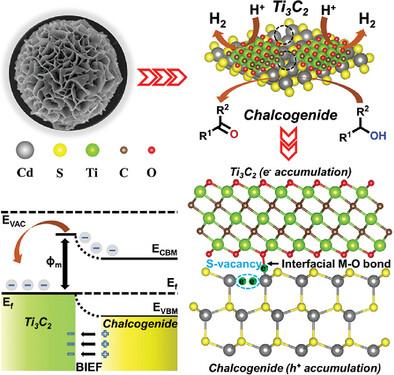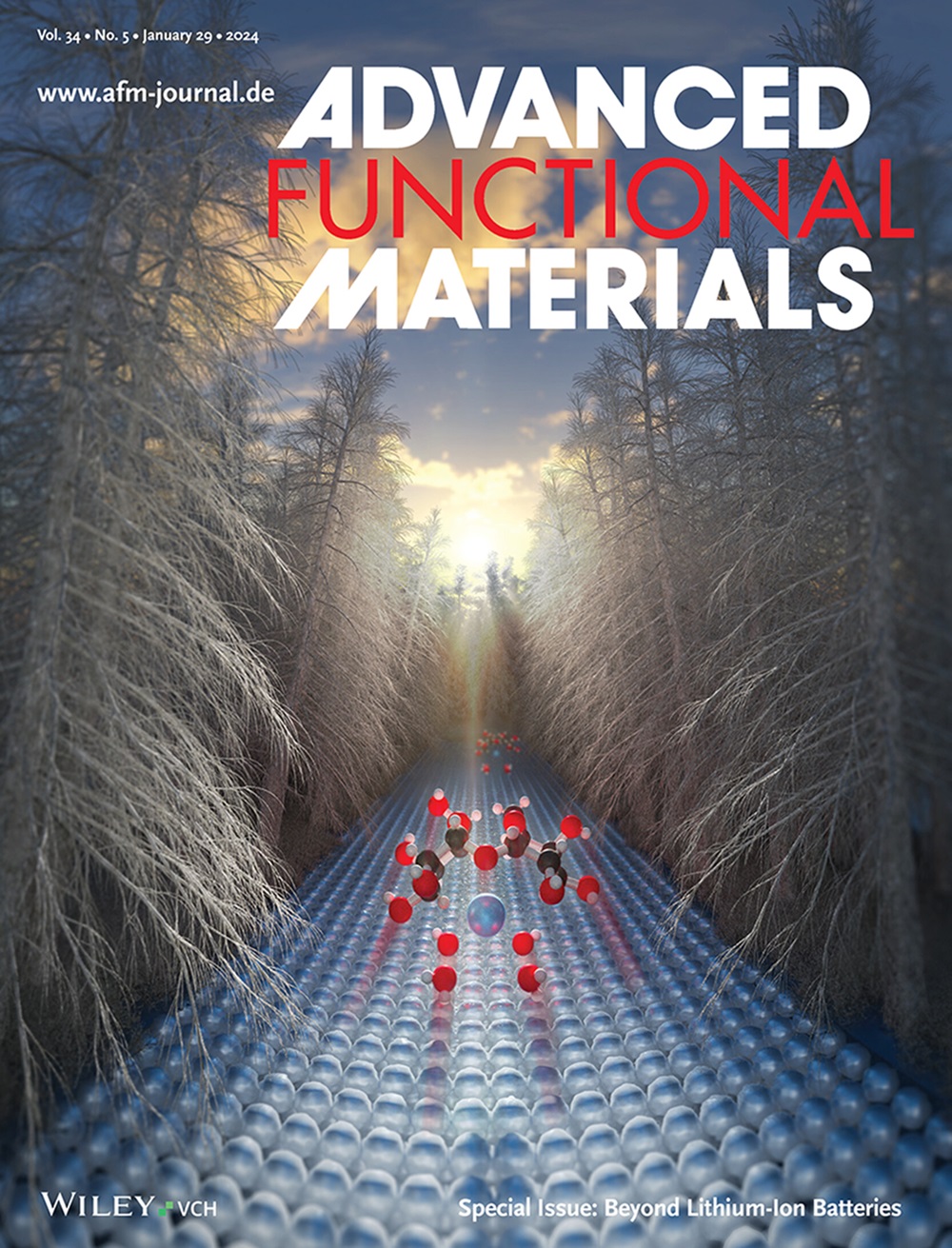通过缺陷介导的钙钛矿异质结表面化学键构建增强内置电场,实现酒精光氧化与 H2 生产的结合
IF 18.5
1区 材料科学
Q1 CHEMISTRY, MULTIDISCIPLINARY
引用次数: 0
摘要
在充分了解结构-性能关系的基础上合理设计纳米结构是异质结光催化剂中电荷转移定向调节的关键。本研究开发了一种合成双功能 Sv-砷化镓/Ti3C2 肖特基结(Sv = 硫空位,砷化镓包含 CdS、CdIn2S4、ZnIn2S4、ZnS、CuInS2),其特点是通过缺陷介导的异质元件锚定产生巨型内置电场(BIEF),这包括对铬化物的硫空位进行调节,以及通过界面金属─氧(M─O)键在缺陷处锚定 Ti3C2 纳米粒子。这些异质结具有半相干相界的独特界面结构,以及从卤化铝到 Ti3C2 的定向排列 BIEF。增强的 BIEF 形成了不对称的电荷分布,它不仅通过实现电荷载流子定位和非定位电子传输连续性来控制电荷迁移行为,而且还通过优化选择性醇光氧化和 H2 生成过程中的关键中间体吸附/活化(脱氢过程中的*Ar-CH(R2)-OH 和 H2 进化过程中的 H*)来调节分子催化行为。令人鼓舞的是,Sv-千铜化物/Ti3C2 表现出前所未有的性能(效率比未调制的千铜化物高出 13.34 倍),并对各种醇类具有良好的底物兼容性。这项工作证明了表面电子密度控制和界面相互作用调制在调节 BIEF 方面的协同效应,阐明了强化 BIEF 对载流子传输特性和分子催化行为的重大影响。本文章由计算机程序翻译,如有差异,请以英文原文为准。

Enhancing Built-In Electric Field via Defect-Mediated Interfacial Chemical Bond Construction in Chalcogenide Heterojunction for Alcohol Photooxidation Coupled with H2 Production
Rationally designing nanostructures based on an adequate understanding of structure-performance relationships is key for directional charge transfer regulation in heterojunction photocatalysts. A general strategy is developed for synthesizing bifunctional Sv-chalcogenide/Ti3C2 Schottky junctions (Sv = sulfur vacancies, chalcogenides containing CdS, CdIn2S4, ZnIn2S4, ZnS, CuInS2) featuring a giant built-in electric field (BIEF) via defect-mediated heterocomponent anchorage, which consists of sulfur vacancy modulation of chalcogenides and Ti3C2 nanoparticle anchoring at defects via interfacial Metal─Oxygen (M─O) bonds. These heterojunctions have the distinctive interface structure of semicoherent phase boundaries and a directionally aligned BIEF pointing from chalcogenides to Ti3C2. The enhanced BIEF creates an asymmetrical charge distribution, which not only governs the charge migration behavior by enabling charge carrier localization and delocalized electron transport continuity but also regulates the molecular catalytic behavior by optimizing pivotal intermediate adsorption/activation (*Ar-CH(R2)-OH in dehydrogenation and H* in H2 evolution) in selective alcohol photooxidation coupled with H2 generation. Encouragingly, Sv-chalcogenide/Ti3C2 exhibits unprecedented performance (up to 13.34-fold higher efficiency than unmodulated chalcogenides) and good substrate compatibility for various alcohols. This work demonstrates the synergistic effects of surface electron density control and interfacial interaction modulation in regulating BIEFs, elucidating the substantial impact of reinforced BIEF on carrier transport properties and molecular catalytic behavior.
求助全文
通过发布文献求助,成功后即可免费获取论文全文。
去求助
来源期刊

Advanced Functional Materials
工程技术-材料科学:综合
CiteScore
29.50
自引率
4.20%
发文量
2086
审稿时长
2.1 months
期刊介绍:
Firmly established as a top-tier materials science journal, Advanced Functional Materials reports breakthrough research in all aspects of materials science, including nanotechnology, chemistry, physics, and biology every week.
Advanced Functional Materials is known for its rapid and fair peer review, quality content, and high impact, making it the first choice of the international materials science community.
 求助内容:
求助内容: 应助结果提醒方式:
应助结果提醒方式:


